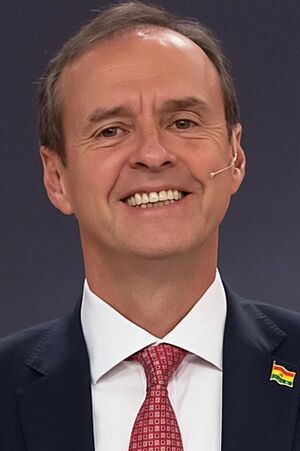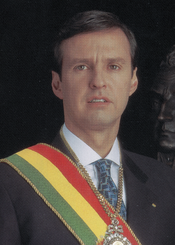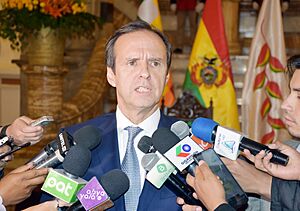Jorge Quiroga facts for kids
Quick facts for kids
Jorge Quiroga
OCA OSP
|
|
|---|---|

Quiroga in 2025
|
|
| 62nd President of Bolivia | |
| In office 7 August 2001 – 6 August 2002 |
|
| Vice President | None |
| Preceded by | Hugo Banzer |
| Succeeded by | Gonzalo Sánchez de Lozada |
| 36th Vice President of Bolivia | |
| In office 6 August 1997 – 7 August 2001 |
|
| President | Hugo Banzer |
| Preceded by | Víctor Hugo Cárdenas |
| Succeeded by | Carlos Mesa (2003) |
| Minister of Finance | |
| In office 17 March 1992 – 12 November 1992 |
|
| President | Jaime Paz Zamora |
| Preceded by | David Blanco Zabala |
| Succeeded by | Juan Pablo Zegarra |
| Bolivia's International Delegate to denounce Human Rights violations | |
| In office 2 December 2019 – 8 January 2020 |
|
| President | Jeanine Áñez |
| Preceded by | Position established |
| Succeeded by | Position abolished |
| Personal details | |
| Born |
Jorge Fernando Quiroga Ramírez
5 May 1960 Cochabamba, Bolivia |
| Political party | Independent (since 2019) |
| Other political affiliations |
ADN (1993–2005) PODEMOS (2005–2009) PDC (2014–2019) Libre (since 2024) |
| Spouses |
Virginia Gillum
(m. 1989, divorced)Milena Dobronic
(m. 2025) |
| Children | 4 |
| Alma mater | Texas A&M University St. Edward's University |
| Signature |  |
Jorge Fernando Tuto Quiroga Ramírez was born on May 5, 1960. He is a Bolivian politician and an industrial engineer. He served as the 62nd president of Bolivia from 2001 to 2002.
Before becoming president, he was the 36th vice president from 1997 to 2001. He worked alongside Hugo Banzer, who was president at the time. In 1992, he also served as the Minister of Finance.
Later, during the government of Jeanine Áñez, he was an international spokesperson. His role was to speak out about important issues for Bolivia. Quiroga ran for president in the 2005 and 2014 elections. In both elections, he represented the Christian Democratic Party.
In the 2020 presidential election, Quiroga was a candidate for the Libre21 group. He later withdrew his candidacy to help unite other political groups. He ran for president again in the 2025 general election. He placed second in the first round but was defeated in the runoff election against Senator Rodrigo Paz Pereira.
Contents
Who is Jorge Quiroga?
Early Life and Education
Jorge Quiroga was born in Cochabamba, Bolivia, on May 5, 1960. He moved to the United States for his studies. In 1981, he graduated from Texas A&M University with a degree in industrial engineering. This field is about designing and improving systems to make things work more efficiently. He was the first head of state to come from that university.
After college, he worked for IBM in Austin, Texas. While working, he earned a master's degree in business administration from St. Edward's University. He then returned to Bolivia with his first wife, Virginia Gillum, who is American. They had four children: Vanessa Elena, Cristina Andrea, Adriana Patricia, and Jorge Cristian. Quiroga and Gillum divorced in 2008. On April 19, 2025, he married Milena Dobronic.
A Young Leader: Vice President
Quiroga began his career in public service as the Minister of Finance in 1992. This role involved managing Bolivia's money and economy. In 1997, he was elected as the Vice President of Bolivia. He ran with Hugo Banzer, a former president.
At 37 years old, Quiroga was the youngest vice president in Bolivia's history. He served in this important role until 2001.
Leading Bolivia: President Quiroga
Jorge Quiroga became president when Hugo Banzer resigned due to health reasons. Quiroga took over as acting president on July 1, 2001. He was officially sworn in on August 7, 2001. He completed the remaining year of Banzer's five-year term.
In his inauguration speech, Quiroga spoke highly of Banzer. He also recognized the economic challenges Bolivia faced at that time. He made history by being the first president since 1896 to be sworn into office in Sucre, Bolivia's constitutional capital.
Important Ideas During His Presidency
As president, Quiroga had big plans for Bolivia. He believed Bolivia could become "the vital heart of South America." He thought that exporting natural gas would boost the economy. He also hoped for a major highway connecting Brazil to Chile, passing through Cochabamba. He envisioned new fibre-optic cables to improve communication.
Quiroga also spoke about fair trade. He noted that Bolivia had a very open economy. However, he felt that trade rules from countries like the United States and Europe made it hard for Bolivia to sell its products. He believed these rules were unfair to developing countries. He also discussed challenges with water supply in 2000. He said that private investment would be needed to solve these water issues.
After the Presidency: Continued Public Service
After his presidency, Quiroga continued to be active in politics. He ran for president in the 2005 election. He was the candidate for a group called Social and Democratic Power (PODEMOS). He came in second place, losing to Evo Morales.
Quiroga has also worked as a consultant for important international organizations. These include the World Bank and the International Monetary Fund. In 2002, his alma mater, Texas A&M University, honored him with a special exhibit.
He is involved with many international groups. He is the vice-president of the Club de Madrid, which includes nearly 100 former heads of state. He also serves on the board of Results for Development-R4D and is a member of the Inter-American Dialogue. Since 2002, he has led FUNDEMOS, a Bolivian foundation focused on public policy. His work often involves international aid, economic policy, and reforms for South American development. In 2011, he was appointed vice president of the Club de Madrid.
Running for President Again
In December 2019, the government of Jeanine Áñez appointed Quiroga to a special international role. He was tasked with speaking about important issues related to fairness and rights. He held this position for about a month. He then resigned in January 2020 to announce his candidacy for the presidential elections that year.
During the 2020 election campaign, he was consistently in sixth place in opinion polls. On October 11, 2020, a week before the election, Quiroga withdrew from the race. He stated that he hoped his withdrawal would help unite other political groups.
He also served as a senior advisor at New Direction, a research group, until 2023. In 2023, he supported Javier Milei in the Argentine general election. For the 2025 elections, he announced his presidential candidacy. He ran with the alliance Libertad y Democracia ("Freedom and Democracy"), known as Libre. His running mate for vice president was Juan Pablo Velasco.
In the first round of the 2025 election on August 17, he received about 26% of the votes. This placed him second. He then faced Senator Rodrigo Paz in a runoff election on October 19, 2025, where he was defeated.
How Jorge Quiroga Ran in Elections
| Year | Office | Political party | Electoral alliance | Votes | Result | ||||
|---|---|---|---|---|---|---|---|---|---|
| Total | % | P. | |||||||
| 1997 | Vice president | Nationalist Democratic Action | ADN−NFR−PDC | 484,705 | 22.26 | 1st | Won | ||
| 2005 | President | Independent | Social Democratic Power | 821,745 | 28.59 | 2nd | Lost | ||
| 2014 | Christian Democratic Party | 467,311 | 9.04 | 3rd | Lost | ||||
| 2020 | Independent | Libre 21 | Dropped out | Lost | |||||
| 2025 | Independent | Libre | 1,430,176 | 26.70 | 2nd | Lost | |||
| Lost | |||||||||
| Source: Plurinational Electoral Organ | Electoral Atlas | |||||||||
See also
 In Spanish: Jorge Quiroga Ramírez para niños
In Spanish: Jorge Quiroga Ramírez para niños
- Cabinet of Jorge Quiroga
- List of presidents of Bolivia
- Politics of Bolivia



